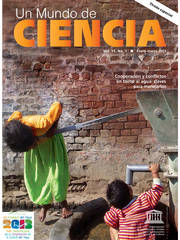Vol 11, No. 3 [Julio - Septiembre 2013]
| EDITORIAL |
A marriage of reason
Of the more than 80 international centres which operate under the auspices of UNESCO (category 2 centres), half specialize in the natural sciences and as many as one-third in freshwater-related issues. These are in addition to the ‘category 1’ centres, which are part and parcel of UNESCO and include the UNESCO-IHE Institute for Water Education and the Abdus Salam International Centre for Theoretical Physics.
Until this year, not one of the ‘category 2’ centres mentioned climate change in its name. That changed in March with the launch of the UNESCO−Avina Foundation Regional Centre for Climate Change and Decision Making (Montevideo, Uruguay), followed, just a month later, by the Centre on Water for Sustainable Development and Adaptation to Climate Change (Belgrade, Serbia). This shows that climate change and related decision-making have become a dual concern.
The Montevideo centre will train managers and decision-makers from the public and private sectors of Argentina, Brazil, Chile, Paraguay and Uruguay in issues related to climate change, with an emphasis on handling negotiations and the socio-economics of climate change.
The Belgrade centre will foster scientific cooperation and the exchange of information in the subregion, while running a parallel programme to raise awareness among decision-makers and the general public of the need to adapt to climate change.
The protracted negotiations towards an agreement to replace the Kyoto Protocol illustrate the complementarity between science and decision-making. For lack of a political consensus, the global climate talks have stalled, even though the science shows that urgent action is needed to keep global warming to 2°C this century. Knowledge is power but only if it translates into policy.
Effective environmental governance requires solid ties between science and policy. An interesting experiment in this area is currently taking place along the course of the world’s longest river, the Nile. After a decade of working in parallel, the intergovernmental Nile Basin Initiative signed a Memorandum of Understanding last year with the Nile Basin Capacity Building Network, an informal group of scientists from the Nile Basin countries. ‘This agreement not only acknowledges the complementarity of the twin mechanisms,’ observe authors Carel Keuls and Jan Luijendijk from the UNESCO-IHE in Networking on the Nile, ‘it also underscores the need for both formal and informal avenues of cooperation to improve knowledge of the Nile Basin.’ In this instance, the bridges thrown between decision-makers and scientists will benefit all the countries in the basin.
One of the fruits of this alliance is the decision support system developed by the Nile Basin Initiative. This computer-based information system ‘enables countries to model and simulate the likely consequences of a planned development scheme before it leaves the drawing board’. This should foster ‘a dispassionate political dialogue based on scientific fact,’ note the authors. Governments are currently integrating this system into their water management bodies. In parallel, the UNESCO-IHE has been training water specialists from the Nile Basin how to develop and use the system.
In the past decade, climate change has become a recurrent focus of the research done by the Nile Basin Capacity Building Network. This growing body of knowledge will feed into the decision support system, enabling decision-makers to weigh up their options on the basis of sound science.
Gretchen Kalonji
Assistant Director-General for Natural Sciences






